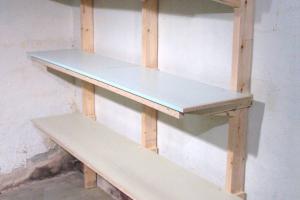Ultimate Guide to Building Custom Shelves: A Step-by-Step Approach

-
Quick Links:
- Introduction
- Benefits of Building Your Own Shelves
- Planning Your Shelves
- Materials Needed
- Essential Tools for Shelf Building
- Design Ideas for Custom Shelves
- Step-by-Step Guide to Building Shelves
- Case Studies and Examples
- Expert Insights and Tips
- FAQs
Introduction
Building shelves can be a fulfilling project that not only enhances your home but also allows for creativity and personalization. This comprehensive guide will walk you through the entire process, from planning your shelves to the final assembly. Whether you're a beginner or an experienced woodworker, you’ll find valuable insights to help you succeed.
Benefits of Building Your Own Shelves
Building your own shelves comes with numerous advantages:
- Customization: Tailor the size, style, and finish to perfectly fit your space.
- Cost-Effective: Save money compared to purchasing pre-made shelves.
- Quality Control: Ensure high-quality materials and craftsmanship.
- Satisfaction: Experience the joy of creating something with your own hands.
- Skills Development: Improve your woodworking and DIY skills.
Planning Your Shelves
Before you start building, effective planning is essential. Consider the following:
- Location: Identify where you want to install the shelves.
- Purpose: Determine what the shelves will hold (books, decor, etc.).
- Dimensions: Measure the available space and decide on shelf dimensions.
Materials Needed
Here’s a list of materials you might need for your shelving project:
- Wood (plywood, MDF, or solid wood)
- Wood glue
- Wood screws
- Brackets or shelf supports
- Finish (paint, stain, or sealant)
Essential Tools for Shelf Building
To build shelves, you will need the following tools:
- Measuring tape
- Level
- Drill
- Saw (circular saw or miter saw)
- Screwdriver
- Sander
Design Ideas for Custom Shelves
Consider these design ideas to inspire your shelving project:
- Floating Shelves: Minimalistic and modern, great for small spaces.
- Corner Shelves: Utilize corner spaces effectively.
- Built-in Shelves: Seamlessly integrate shelves into existing walls.
- Adjustable Shelves: Create versatile storage solutions with adjustable heights.
Step-by-Step Guide to Building Shelves
Step 1: Gather Your Materials and Tools
Ensure you have all the materials and tools listed above ready before starting.
Step 2: Measure and Mark
Use your measuring tape to mark where your shelves will go. Use a level to ensure your marks are straight.
Step 3: Cut the Wood
Using your saw, cut the wood to the desired dimensions. Always wear safety gear when using power tools.
Step 4: Assemble the Shelves
Using wood glue and screws, assemble your shelf pieces. Allow glue to dry according to manufacturer's instructions.
Step 5: Install the Shelves
Attach brackets or supports to the wall, then secure your shelves onto them.
Step 6: Finish the Shelves
Apply your chosen finish to protect the wood and enhance its appearance.
Case Studies and Examples
Many DIY enthusiasts have successfully built their own shelves. For example, a recent survey by the National Association of Home Builders found that over 70% of homeowners prefer custom-built shelving for its unique design and functionality. Below are a few examples:
- Example 1: A homeowner transformed a small living room corner with floating shelves, showcasing plants and books.
- Example 2: A kitchen remodel included built-in shelves that provided additional storage for cookware and spices.
Expert Insights and Tips
According to woodworking expert John Smith of Woodworking Magazine, “Planning is key. Spend time deciding the type of shelves that suit your needs before you start building.” Here are some additional tips:
- Choose high-quality wood for durability.
- Always double-check measurements before cutting.
- Use a finish that complements your home decor.
FAQs
1. What type of wood is best for building shelves?
Hardwoods like oak or maple are durable, while plywood and MDF are cost-effective options for DIY shelves.
2. How much weight can floating shelves hold?
Floating shelves can typically hold between 20-50 pounds, depending on the installation method and materials used.
3. Do I need special tools to build shelves?
Basic tools like a saw, drill, and level are sufficient for most shelf-building projects.
4. Can I build shelves in a small space?
Yes! Floating shelves and corner shelves are great options for maximizing storage in small areas.
5. How do I finish my shelves?
You can stain, paint, or seal your shelves depending on your desired look and protection level.
6. Is it difficult to build shelves?
With careful planning and following instructions, building shelves is a manageable DIY project for most skill levels.
7. What are adjustable shelves?
Adjustable shelves allow you to change the height of the shelves based on your storage needs.
8. How long does it take to build shelves?
Building shelves can take a few hours to a couple of days, depending on the complexity and materials.
9. Can I install shelves without brackets?
Yes, floating shelves are an option that doesn’t require visible brackets.
10. What if I make a mistake while building?
Don’t worry! Mistakes are part of the learning process. Measure twice and cut once to minimize errors.
Random Reads
- How to wire an electric dryer
- How to woohoo in the sims 2
- How to automatically forward emails to your gmail account
- Google basics search mail maps more
- Google gravity trick
- How to wipe an external hard drive
- How to wire a 220v outlet
- Customize rgb lighting gaming pc
- Cydia without jailbreaking
- How to connect gaming console to computer monitor